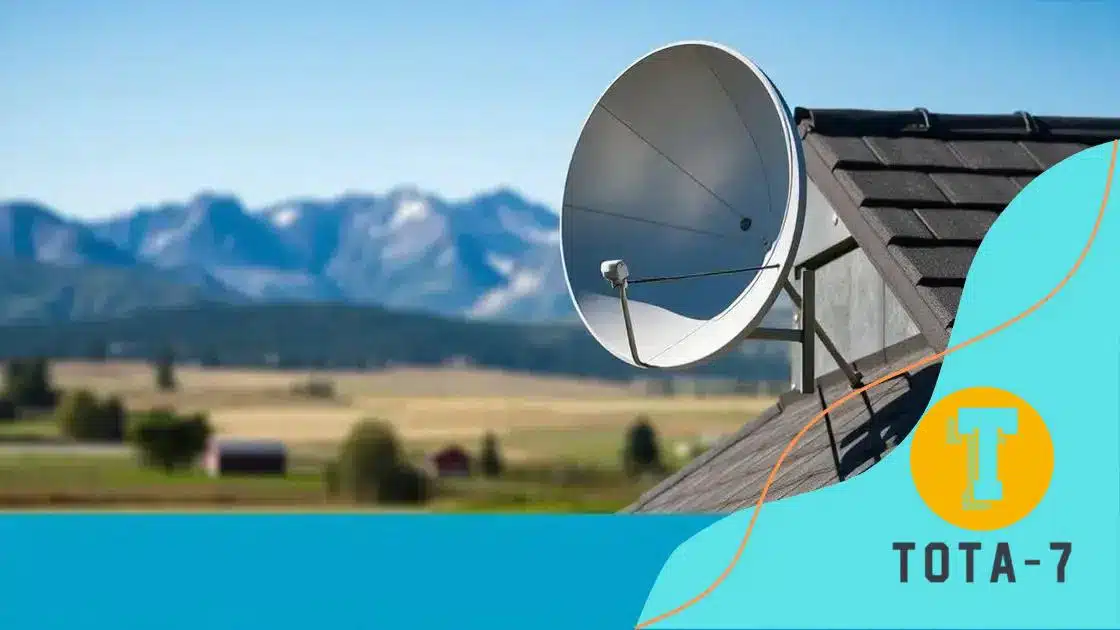Satellite internet providers push for global coverage

Choosing the right satellite internet provider involves assessing your internet needs, comparing pricing, reading customer reviews, and evaluating customer support to ensure reliable and efficient service.
Satellite internet providers push for global coverage, aiming to connect even the most remote areas of the world. Imagine being in a rural area with stable internet access, transforming the way we communicate and work. This article explores the advancements and challenges in satellite connectivity.
Understanding satellite internet technology
Understanding satellite internet technology can be fascinating. This technology allows users to access the internet from virtually anywhere on the globe. Unlike traditional wired internet options, satellite internet relies on a network of satellites orbiting the earth, which helps provide coverage even in remote areas.
How It Works
Satellite internet functions by sending and receiving data to and from a satellite dish installed at the user’s location. The process involves several key components:
- The satellite dish captures signals from the satellite.
- Data is transmitted to the satellite and then relayed back to a ground station.
- The ground station connects to the internet infrastructure.
Once the data is processed, the information travels back to the user, completing the cycle. This entire process happens incredibly fast, enabling users to browse websites, stream videos, and engage in online gaming, even in areas without traditional internet.
Benefits of Satellite Internet Technology
Many satellite internet providers offer benefits that make this technology appealing:
- Accessibility in remote locations.
- Fast installation process.
- Reliable connectivity despite geographical challenges.
These advantages allow individuals and businesses in rural regions to stay connected. As digital demands grow, understanding how satellite internet works becomes increasingly important.
Moreover, advancements in technology lead to improved speeds and reliability. New satellites are being launched to enhance internet service, ensuring better performance in the future. With the ongoing development, users can expect further enhancements in satellite internet experience.
Benefits of global satellite internet connectivity
The benefits of global satellite internet connectivity are significant, especially for those living in remote areas. With the expansion of satellite technology, even the most isolated communities can access reliable internet services. This technology removes barriers that traditional internet has faced, paving the way for increased communication and opportunities.
Improved Accessibility
One major advantage is improved accessibility. Many rural and underserved areas struggle with internet options, leaving residents disconnected from essential online services. Satellite internet provides a viable solution, allowing users to connect effortlessly. This means students can attend online classes, families can stream entertainment, and businesses can operate more efficiently.
- Low infrastructure costs compared to traditional broadband.
- Quick setup time for users.
- Availability during emergencies when other services fail.
- Wide range of coverage, reaching even the most remote locations.
In addition, satellite internet can play a critical role during crises. In disasters where terrestrial networks fail, satellite connections remain operational, ensuring that people can reach loved ones and access vital information. This resilience is essential for safety and communication during emergencies.
Enhanced Collaboration and Growth
Another key benefit lies in the enhanced collaboration between communities and businesses. With reliable internet, small businesses can enter the digital market, reaching customers around the globe. Farmers and producers can sell their products online, promoting local goods outside their immediate area. Overall, this connectivity fosters growth and can lead to economic improvements.
Moreover, individuals can engage in remote work, accessing job opportunities that may not be available locally. This opens doors to skill development and higher wages, enhancing the quality of life for many. With global satellite internet connectivity, the world becomes a more connected place.
Challenges faced by satellite internet providers
Satellite internet providers face several challenges that impact their ability to deliver consistent services. These hurdles can affect both reliability and customer satisfaction, making it crucial to understand their implications.
High Operating Costs
One significant challenge is the high operating costs. Maintaining a satellite network requires substantial investment in technology, infrastructure, and skilled personnel. Launching satellites is expensive, and if one fails, the costs can be even more daunting. This often leads to higher prices for consumers, which can limit accessibility.
- Costs of satellite development and launch.
- Maintenance of ground stations that keep the network operational.
- Skilled workforce needed for technical support and infrastructure management.
Moreover, the technology itself can be complex, requiring ongoing research and development to keep up with advancements in the field.
Weather Interference
Another challenge is weather interference. Heavy rain, snow, and storms can disrupt satellite signals, leading to fluctuating internet speeds or complete outages. This can be frustrating for users who rely on uninterrupted service, particularly in regions with extreme weather. Providers must therefore invest in technology that helps mitigate these disruptions.
Customers often expect a service that is as reliable as traditional broadband, but environmental factors can introduce variability that is hard to control. This means providers must continually seek solutions to enhance stability.
Competition and Market Saturation
Sizable competition from other connectivity options is also a challenge. As more companies emerge offering various internet solutions, satellite providers must innovate to stay relevant. This may involve improving speed, reducing latency, or lowering costs, which can strain resources.
In urban areas, consumers may prefer fiber-optic or cable services that are often faster and more reliable, making it harder for satellite providers to attract customers. Therefore, understanding market dynamics and consumer preferences is critical for success.
Future trends in satellite internet expansion

The future of satellite internet expansion looks promising, with several trends emerging that aim to enhance connectivity worldwide. As technology evolves, the potential for improved internet access through satellites continues to grow.
Increased Satellite Constellations
One major trend is the launch of increased satellite constellations. Companies like SpaceX are deploying thousands of low Earth orbit (LEO) satellites. This approach significantly reduces latency and improves internet speeds by optimizing communication paths.
- Faster speeds that rival traditional broadband.
- Lower latency for smoother online experiences.
- Greater coverage to reach underserved areas.
With more satellites in orbit, the chances of maintaining consistent connections improve, benefiting users in both urban and rural settings.
Technology Advancements
Advancements in technology also play a critical role. Innovations in ground equipment, such as improved satellite dishes and modems, help enhance performance. These devices can automatically adjust to optimize the signal, providing users with a more stable internet experience.
Moreover, technologies like beamforming and frequency division can enhance data transmission, making it easier to manage traffic on networks.
Affordability and Accessibility
The trend towards affordability and accessibility is gaining traction as well. As more satellite providers enter the market, competition leads to better pricing and services. This means that individuals and businesses can enjoy reliable internet at lower costs, breaking down previous barriers to access.
Additionally, organizations and governments are increasingly recognizing the importance of digital inclusion. Investments in satellite infrastructure will likely expand in regions that need it most, promoting economic growth and community development.
How to choose the right satellite internet provider
Choosing the right satellite internet provider is crucial for ensuring you get the best service and connectivity for your needs. With various options available, it can be overwhelming to make the right decision.
Assess Your Internet Needs
Before making a choice, it’s essential to assess your internet needs. Consider how you plan to use the internet, whether for streaming, gaming, or basic browsing. Different providers offer various speeds and data plans, so knowing your requirements will help narrow down your options.
- Check data limits for different plans.
- Look for speed options suitable for activities like streaming or online gaming.
- Evaluate equipment costs, such as modem and satellite dish fees.
By understanding what you need from your satellite internet, you can focus on providers that meet those criteria.
Compare Pricing and Contracts
Next, compare pricing structures and contract terms. It’s vital to ensure that the service you choose fits your budget. Look out for monthly fees, installation charges, and equipment rental costs. Some providers might offer promotional rates that increase after a certain period.
Make sure you understand the terms of any contract, including cancellation fees and service guarantees. An ideal provider will have transparent pricing without hidden fees.
Read Customer Reviews
Reading customer reviews can provide valuable insights into a provider’s reliability and customer service. Look for reviews that discuss internet speed, service interruptions, and how the company handles technical support. A provider with numerous positive reviews may indicate a strong reputation among users.
Consider also checking social media platforms where real users share their experiences and feedback.
Evaluate Customer Support Options
The level of customer support offered by a satellite internet provider is another crucial factor. Ensure the provider offers reliable assistance when needed. Check if they have multiple contact options, such as phone support, live chat, and email. A responsive customer service team can make a significant difference in resolving issues quickly.
With these considerations, you can make a well-informed decision that suits your needs.
FAQ – Frequently Asked Questions about Choosing Satellite Internet Providers
What should I consider when choosing a satellite internet provider?
You should assess your internet needs, compare pricing and contracts, read customer reviews, and evaluate customer support options.
How can I know if a satellite provider is reliable?
Reading customer reviews and ratings can provide insights into the reliability and quality of service of a satellite internet provider.
What type of equipment do I need for satellite internet?
Typically, you will need a satellite dish and a modem provided by the internet provider. Some providers may also require installation services.
Are there any limitations to satellite internet?
Yes, satellite internet may have data caps, and performance can be affected by weather conditions and physical obstructions.
 Assess Your Needs
Assess Your Needs Compare Pricing
Compare Pricing Read Reviews
Read Reviews Check Support
Check Support Make Your Choice
Make Your Choice




